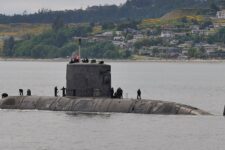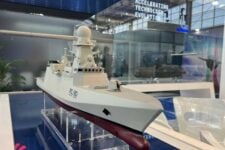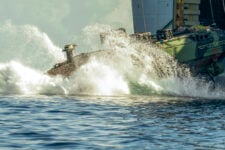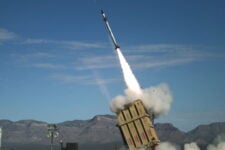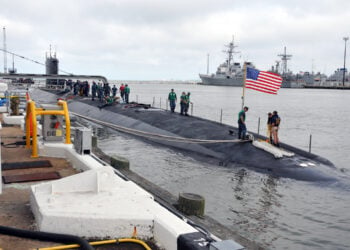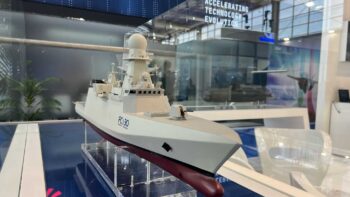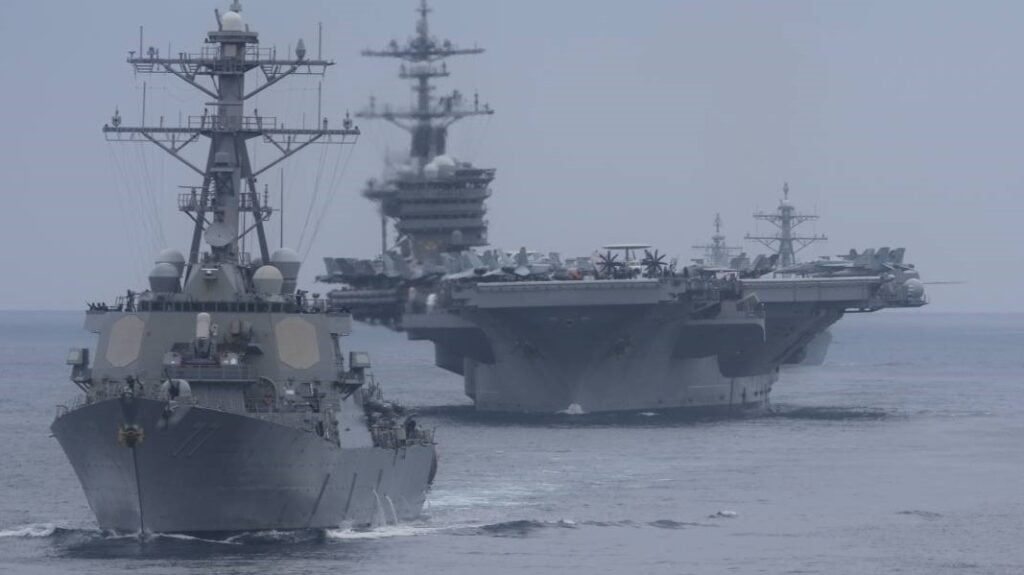
The Navy tested its Project Overmatch battle network on Carrier Strike Group 1, the USS Vinson and its escorts, shown here in the Pacific in 2021 (U.S. Navy photo by Intelligence Specialist 1st Class Alexander Fraser)
SEA AIR SPACE 2024 — The Navy’s secretive Project Overmatch is ahead of schedule and the service is reaching out eagerly to industry for new tech it can fast-track to the fleet, the head of Naval Information Warfare Systems Command said today.
To build the new battle network as fast as possible, Rear Adm. Douglas Small emphasized to ballroom packed with contractors at the Navy League’s Sea Air Space conference, the Navy isn’t looking to buy new hardware it has to wedge into warships already packed with gear: Instead, it’s emphasizing software.
“Fielding software on existing hardware is the fastest way to move,” Small said. “That has been our mantra: just focus on software.”
“[So] what we need is the applications — not new computers, that takes longer to install on ships,” Small said. “We have plenty of contract vehicles to get your software into the brains of sailors tomorrow.” (An aide made clear that the admiral was using a creative twist on the expression “into the hands of…,” not implying a cyberpunk implant like Elon Musk’s Neuralink).
That software helps build up Project Overmatch, the Navy’s piece of the Pentagon’s ambitious global network initiative known as Combined Joint All Domain Command & Control. Deputy Defense Secretary Kathleen Hicks announced in February that an early version of CJADC2 — a “Minimum Viable Capability” — was now in service. From officials’ descriptions, this all-service system focuses on streamlining planning and coordination among the military’s four-star theater headquarters, the 11 Combatant Commands.
Meanwhile the service-specific segments focus on lower echelons closer to the fight. That aspect is often described as automated flow of target data from “sensors to shooters,” but Small called this shorthand simplistic. Yes, part of Overmatch involves getting Navy weapons better targeting data, he said, such as radar tracks of hostile missiles and aircraft, but it’s at least as important to keep human commanders well-informed of what’s happening around them so they can make better decisions more quickly.
Even more than other services, the Navy has kept details of its CJADC2 tech close to the vest, but an early version of Overmatch is already installed on three Carrier Strike Groups — CSGs 1, 4, and 15 — as well as operational “numbered fleet” headquarters ashore, Small said.
“We’re ahead of the timeline that CNO laid out in the NavPlan,” he said. That’s a reference to the Navy’s 2022 Navigation Plan, which called for an operational test of what’s known as Naval Operational Architecture by the end of last year.
RELATED: Why are details of Navy’s Project Overmatch so scarce? Adversary eyes, for one
This kind of rapid deployment requires a relentless focus on software, because it’s far easier to install and keep updated than physical machinery — easier, that is, as long as the code is compatible and a streamlined process is in place. (That process is known in the trade as agile development or DevSecOps, referring to the blending of Development, Security, and Operations in a continuous feedback loop). The Navy uses “end-to-end DevSecOps,” Small said, and can send out at least some software updates “over the air” to ships at sea, rather than requiring them to come back to the shipyard as is necessary for physical refits.
The goal is to “stay agile,” the admiral said. “As new things come in, they get plugged into the architecture” that already exists, he said. “[We] focused on starting with what we have … mature but critical technologies.”
The Navy is conducting a series of industry days with interested contractors — most of them classified at one level or another — and in some cases in partnership with the Air Force, Small said. But if a company can’t wait for an industry day or doesn’t know where to start with Project Overmatch, “just get a hold of me,” the admiral said before offering his email address. “I will take your meeting or get you connected.”



